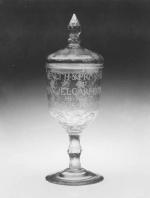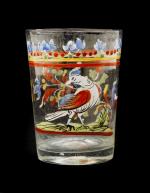![header=[Marker Text] body=[The famed glassmaker and ironmaster of colonial days founded Manheim in 1762, and set up his glassworks in 1764. He gave land for the Lutheran Church which still pays his heirs one red rose a year. ] sign](http://explorepahistory.com/kora/files/1/10/1-A-33A-139-ExplorePAHistory-a0l2r2-a_450.jpg)
Mouse over for marker text
Name:
Baron Stiegel
Region:
Hershey/Gettysburg/Dutch Country Region
County:
Lancaster
Marker Location:
Pa. 72 at Square in Manheim
Dedication Date:
March 19, 1947
Behind the Marker
For about a decade in the eighteenth century, Henry Stiegel, a German immigrant, produced high-quality glassware in Lancaster County. Today, Stiegel glass is highly valued by collectors, who consider it fine art. To this day, locals refer to him as "Baron" Stiegel, despite his lack of European pedigree. Stiegel never officially used the title but probably adopted it informally at some point and allowed his employees and neighbors to use it.
In reality, Heinrich Wilhelm Stiegel's origin was not very grand. Born near Cologne, in 1729, he emigrated to Philadelphia with his widowed mother and brother in 1750. His family came from the Palatinate, a long-suffering region from which many Germans came to America in the early 1700s. In 1752, he secured a position with ironmaster Jacob Huber, who ran Elizabeth Furnace in Lancaster County.
Stiegel may have had previous ironworking experience, and he quickly excelled as Huber's clerk. Stiegel did more than impress his employer; he married his daughter Elizabeth, for whom the furnace was named. Stiegel and his father-in-law jointly ran the furnace for several years. In 1756, Stiegel brought in outside investors from Philadelphia, Charles and Alexander Stedman, who helped him operate it.
Into the 1760s, Stiegel and the Stedmans acquired land and expanded their iron interests. They quickly bought up several thousand acres of property adjoining the Elizabeth Furnace. Stiegel independently formed a partnership with Michael Gross, a Lancaster merchant, to buy another forge in Berks County a few miles north of Wolmelsdorf. Stiegel added several thousand acres to the property and renamed it "Charming Forge." A few years later, the Stedmans bought out Gross's interest in the place. Meanwhile, the three partners bought up a 749-acre tract in Rapho Township.
"Charming Forge." A few years later, the Stedmans bought out Gross's interest in the place. Meanwhile, the three partners bought up a 749-acre tract in Rapho Township.
As his businesses prospered, Stiegel started a new venture that would immortalize his name: glassmaking. The charcoal fires of Elizabeth Furnace could easily be used to fuse glass. In September 1763, he began glass production at Elizabeth with ten craftsmen, focusing on readily sold bottles and window glass. Stiegel decided not to base his glassmaking at Elizabeth Furnace, however. Instead, he chose to build it in a new town on the Rapho Township tract. He named his new locale Manheim after nearby Manheim Township, but for a century local farmers referred to it as "Stiegel Stadtel." Stiegel built an imposing mansion before the factory, showing a predilection for extravagance He then built the glassworks, which started production in November 1765. It proved a great success.
imposing mansion before the factory, showing a predilection for extravagance He then built the glassworks, which started production in November 1765. It proved a great success.
Stiegel and glassmaking soon became synonymous as he advertised and marketed his wares across the colonies. He had agents in all the major colonial cities and across Pennsylvania and Maryland. Stiegel's products had all the refinement of imported articles from England, no doubt due to the skill of the German, English, Irish, and Venetian artisans he brought to his works. Stiegel made decanters, bottles, cruets, vials, toys, mugs, and glasses of many sizes and shapes. With time, he introduced several colors of glass, including green, brown, flint, or "Stiegel" blue, white, amethyst, and amber.
Although his future looked bright in 1766-1767, his fortune soon turned for the worse. England began imposing a series of taxes on its colonies in the late 1760s. The new duties harmed American manufactures, stifled innovation, and reduced the number of customers for fine glassware. Stiegel had to buy out his partners, but he did so by mortgaging his properties.
The profits from the glassworks were not high enough to pay off his increasing debts. Moreover, Stiegel's building projects throughout the area, coupled with an extravagant lifestyle, drained away still more money. Although he had managed to remain the sole owner of Manheim, the glassworks, and both the Elizabeth Furnace and Charming Forge, his wealth existed mostly on paper.
In 1769, he built a new glassworks to accommodate a hundred or more workers, convinced that the increased production would find markets. He was right. He assiduously advertised his wares, now calling his works the American Flint Glass Manufactory. As a result, 1772 and 1773 were good years. But they were not good enough. Stiegel's debts finally caught up with him in 1774. He lost property after property and finally spent a few weeks in debtors" prison.
Stiegel died penniless in 1785 and was buried in an unmarked grave. Yet, a main thoroughfare in Manheim still bears his name, carrying travelers past the lot where his glassworks stood until 1812. Although Stiegel lacks a gravestone, his name lives on. His glassware is featured in the Metropolitan Museum of Art's Hunter Collection and can also be seen in the Philadelphia Museum of Art.
In reality, Heinrich Wilhelm Stiegel's origin was not very grand. Born near Cologne, in 1729, he emigrated to Philadelphia with his widowed mother and brother in 1750. His family came from the Palatinate, a long-suffering region from which many Germans came to America in the early 1700s. In 1752, he secured a position with ironmaster Jacob Huber, who ran Elizabeth Furnace in Lancaster County.
Stiegel may have had previous ironworking experience, and he quickly excelled as Huber's clerk. Stiegel did more than impress his employer; he married his daughter Elizabeth, for whom the furnace was named. Stiegel and his father-in-law jointly ran the furnace for several years. In 1756, Stiegel brought in outside investors from Philadelphia, Charles and Alexander Stedman, who helped him operate it.
Into the 1760s, Stiegel and the Stedmans acquired land and expanded their iron interests. They quickly bought up several thousand acres of property adjoining the Elizabeth Furnace. Stiegel independently formed a partnership with Michael Gross, a Lancaster merchant, to buy another forge in Berks County a few miles north of Wolmelsdorf. Stiegel added several thousand acres to the property and renamed it
As his businesses prospered, Stiegel started a new venture that would immortalize his name: glassmaking. The charcoal fires of Elizabeth Furnace could easily be used to fuse glass. In September 1763, he began glass production at Elizabeth with ten craftsmen, focusing on readily sold bottles and window glass. Stiegel decided not to base his glassmaking at Elizabeth Furnace, however. Instead, he chose to build it in a new town on the Rapho Township tract. He named his new locale Manheim after nearby Manheim Township, but for a century local farmers referred to it as "Stiegel Stadtel." Stiegel built an
Stiegel and glassmaking soon became synonymous as he advertised and marketed his wares across the colonies. He had agents in all the major colonial cities and across Pennsylvania and Maryland. Stiegel's products had all the refinement of imported articles from England, no doubt due to the skill of the German, English, Irish, and Venetian artisans he brought to his works. Stiegel made decanters, bottles, cruets, vials, toys, mugs, and glasses of many sizes and shapes. With time, he introduced several colors of glass, including green, brown, flint, or "Stiegel" blue, white, amethyst, and amber.
Although his future looked bright in 1766-1767, his fortune soon turned for the worse. England began imposing a series of taxes on its colonies in the late 1760s. The new duties harmed American manufactures, stifled innovation, and reduced the number of customers for fine glassware. Stiegel had to buy out his partners, but he did so by mortgaging his properties.
The profits from the glassworks were not high enough to pay off his increasing debts. Moreover, Stiegel's building projects throughout the area, coupled with an extravagant lifestyle, drained away still more money. Although he had managed to remain the sole owner of Manheim, the glassworks, and both the Elizabeth Furnace and Charming Forge, his wealth existed mostly on paper.
In 1769, he built a new glassworks to accommodate a hundred or more workers, convinced that the increased production would find markets. He was right. He assiduously advertised his wares, now calling his works the American Flint Glass Manufactory. As a result, 1772 and 1773 were good years. But they were not good enough. Stiegel's debts finally caught up with him in 1774. He lost property after property and finally spent a few weeks in debtors" prison.
Stiegel died penniless in 1785 and was buried in an unmarked grave. Yet, a main thoroughfare in Manheim still bears his name, carrying travelers past the lot where his glassworks stood until 1812. Although Stiegel lacks a gravestone, his name lives on. His glassware is featured in the Metropolitan Museum of Art's Hunter Collection and can also be seen in the Philadelphia Museum of Art.









